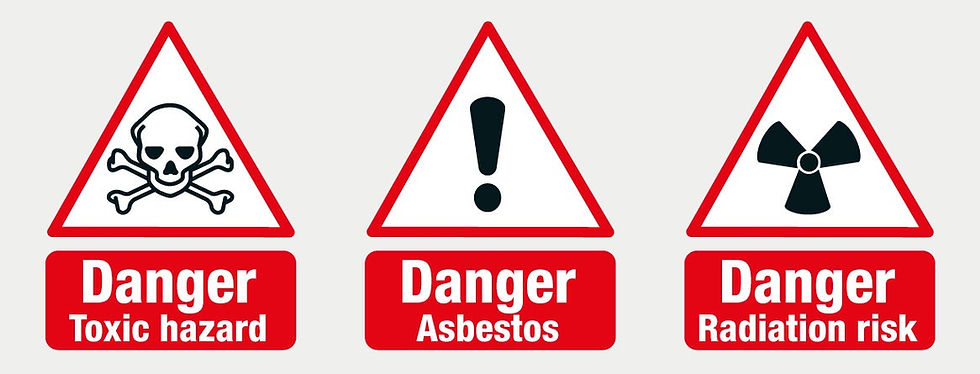What Is The Difference Between A COSHH Assessment And A Risk Assessment ?
- Maria Garcia
- Feb 16, 2023
- 3 min read
Updated: Feb 24, 2023

The COSHH evaluation comprises critical information about the health and safety concerns posed by chemicals/substances, as well as the necessary exposure control measures, first aid needs, spillage containment, and safe disposal requirements. This information is then used by the competent COSHH person so that they have the facts they need to avoid and regulate exposure to these dangers.
A widespread misperception is that a risk assessment is merely identifying a substance's dangerous features; however, this is not the case. A COSHH risk assessment is intended to establish specific controls for the use of a substance that are tailored to the specific usage of a material by a company. A COSHH evaluation is used to ensure that control mechanisms are in place to avoid or control exposure to hazardous substances. In practise, a risk assessment will show that appropriate judgement was used to arrive at conclusions.
The COSHH evaluation comprises critical information about the health and safety concerns posed by chemicals/substances, as well as the necessary exposure control measures, first aid needs, spillage containment, and safe disposal requirements. This information is then used by the competent COSHH person so that they have the facts they need to avoid and regulate exposure to these dangers.
A COSHH assessment is a health and safety document that focuses on a single drug. A COSHH examination is typically related with any cleaning products used in the workplace. COSHH assessments not only inform people about the risks of a drug and what PPE to wear to reduce the risk of contact or exposure, but they also tell them how to properly dispose of a substance and what to do if something goes wrong.
COSHH, or Control of Substances Hazardous to Health, is a set of laws implemented by the United Kingdom's Health and Safety Executive (HSE) to safeguard workers from health risks when working with specified compounds and materials. COSHH contains a Risk Assessment component, which, while a legislative compliance requirement for some, is gradually becoming a best practise around the world to assist businesses of all sizes in more effectively preventing or controlling workplace dangers. Continue reading to discover more about COSHH and how VelocityEHS' SDS/Chemical Management system can aid in the simplification of COSHH Risk Assessment.
COSHH Risk Assessment is very important since it is a systematic procedure for analysing the health risks posed by hazardous substances in the workplace and then establishing the appropriate steps for preventing or adequately regulating those risks. COSHH Risk Assessment is a critical framework for companies to better protect workers exposed to risks, regardless of whether they are required by law to comply with COSHH laws.
COSHH laws are complex and difficult to understand, especially if you have never dealt with them before. Our experts can aid and lead your company through the complexity of COSHH regulations, delivering assistance and direction every step of the way. We can provide practical guidance that is totally targeted to your firm, allowing you to comprehend the requirements and develop a COSHH strategy that keeps your company and its employees completely safe and compliant.
A COSHH evaluation assists you in identifying the hazards and risks associated with hazardous substances in your workplace. Simply said, it is a complete risk assessment that focuses on the hazardous material exposure in your workplace. A COSHH assessment is only required if hazardous substances are expected to be present in your workplace.
Yet, the greater the severity and complexity of the hazards, as well as the size of your workplace, the more probable it is that you will need to contact persons with technical experience in occupational hygiene and involve more people in your assessment process. This is especially critical if your company has multiple departments that all use various hazardous substances and work processes.
You must also ensure that you can handle everyone engaged effectively. As a result, you must appoint someone to oversee the process - this might be you or another competent individual - or establish a central coordinating body. The designated individual or coordinating body is in charge of selecting competent team members, explicitly defining individual roles, and providing direction throughout the process.
You may not always be aware of which compounds are hazardous in your workplace. This is due to the fact that dangerous compounds are not usually labelled with hazard symbols. Flowers, bulbs, some fungi, wet cement, and glue, for example, are all classified as hazardous substances under COSHH. Furthermore, if you operate in a manufacturing plant, you must evaluate the intermediates, bi-products, end products, and so on of all your operations, as these may also be hazardous.
Our specialist H&S Department team can give further support and advise your firm on the protective equipment required to maintain compliance, in addition to aiding directly with COSHH assessments. We may also assist you in developing emergency plans, which detail how to respond in the event of an accident or emergency, such as identifying probable mishaps, advising on suitable first aid care, and evacuation tactics.


Comments